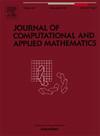A machine learning radial basis deep neural network for solving the fractional chaotic financial system
IF 2.6
2区 数学
Q1 MATHEMATICS, APPLIED
Journal of Computational and Applied Mathematics
Pub Date : 2025-07-17
DOI:10.1016/j.cam.2025.116936
引用次数: 0
Abstract
In this study, a machine learning radial basis deep neural network process is presented with the optimization of Bayesian regularization for solving the fractional order chaotic financial system, which is divided into four different categories. This novel designed machine learning procedure contains two hidden layers with 15 and 30 neurons in the feed-forward neural network, radial basis activation function, and optimization of Bayesian regularization. A fractional Caputo derivative is used to present more reliable solutions of the chaotic financial system as compared to integer order. The construction of the data is performed through the Adam solver to reduce the mean square error by splitting the statics into training 80 %, while 9 %, 9 % for both testing and authentication. Three different model’s cases are used to check the correctness of the deep neural network solver through the comparison and small absolute error. Moreover, the reliability of the novel designed solver is observed by using different measures based on regression coefficient, state transition, error histogram and best training values.
求解分数阶混沌金融系统的机器学习径向基深度神经网络
本研究提出了一种基于贝叶斯正则化优化的机器学习径向基深度神经网络过程,用于求解分数阶混沌金融系统,该系统分为四类。该算法采用前馈神经网络、径向基激活函数和贝叶斯正则化优化的方法,分别包含15和30个神经元的隐藏层。采用分数阶卡普托导数,给出了混沌金融系统比整数阶更可靠的解。数据的构建通过Adam求解器进行,通过将静量分为训练80%,测试9%,验证9%,来减小均方误差。利用三种不同模型的实例,通过比较和较小的绝对误差来检验深度神经网络求解器的正确性。此外,通过基于回归系数、状态转移、误差直方图和最佳训练值的不同度量来观察新设计求解器的可靠性。
本文章由计算机程序翻译,如有差异,请以英文原文为准。
求助全文
约1分钟内获得全文
求助全文
来源期刊
CiteScore
5.40
自引率
4.20%
发文量
437
审稿时长
3.0 months
期刊介绍:
The Journal of Computational and Applied Mathematics publishes original papers of high scientific value in all areas of computational and applied mathematics. The main interest of the Journal is in papers that describe and analyze new computational techniques for solving scientific or engineering problems. Also the improved analysis, including the effectiveness and applicability, of existing methods and algorithms is of importance. The computational efficiency (e.g. the convergence, stability, accuracy, ...) should be proved and illustrated by nontrivial numerical examples. Papers describing only variants of existing methods, without adding significant new computational properties are not of interest.
The audience consists of: applied mathematicians, numerical analysts, computational scientists and engineers.

 求助内容:
求助内容: 应助结果提醒方式:
应助结果提醒方式:


